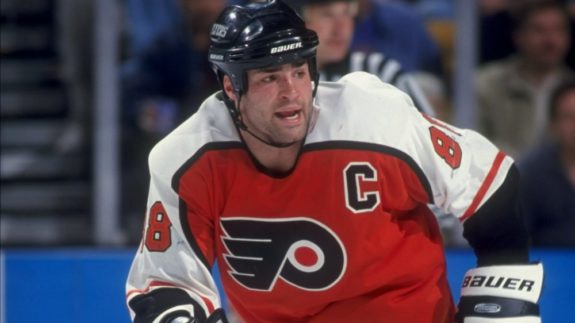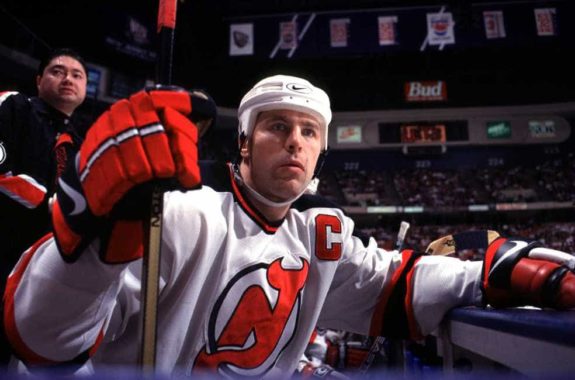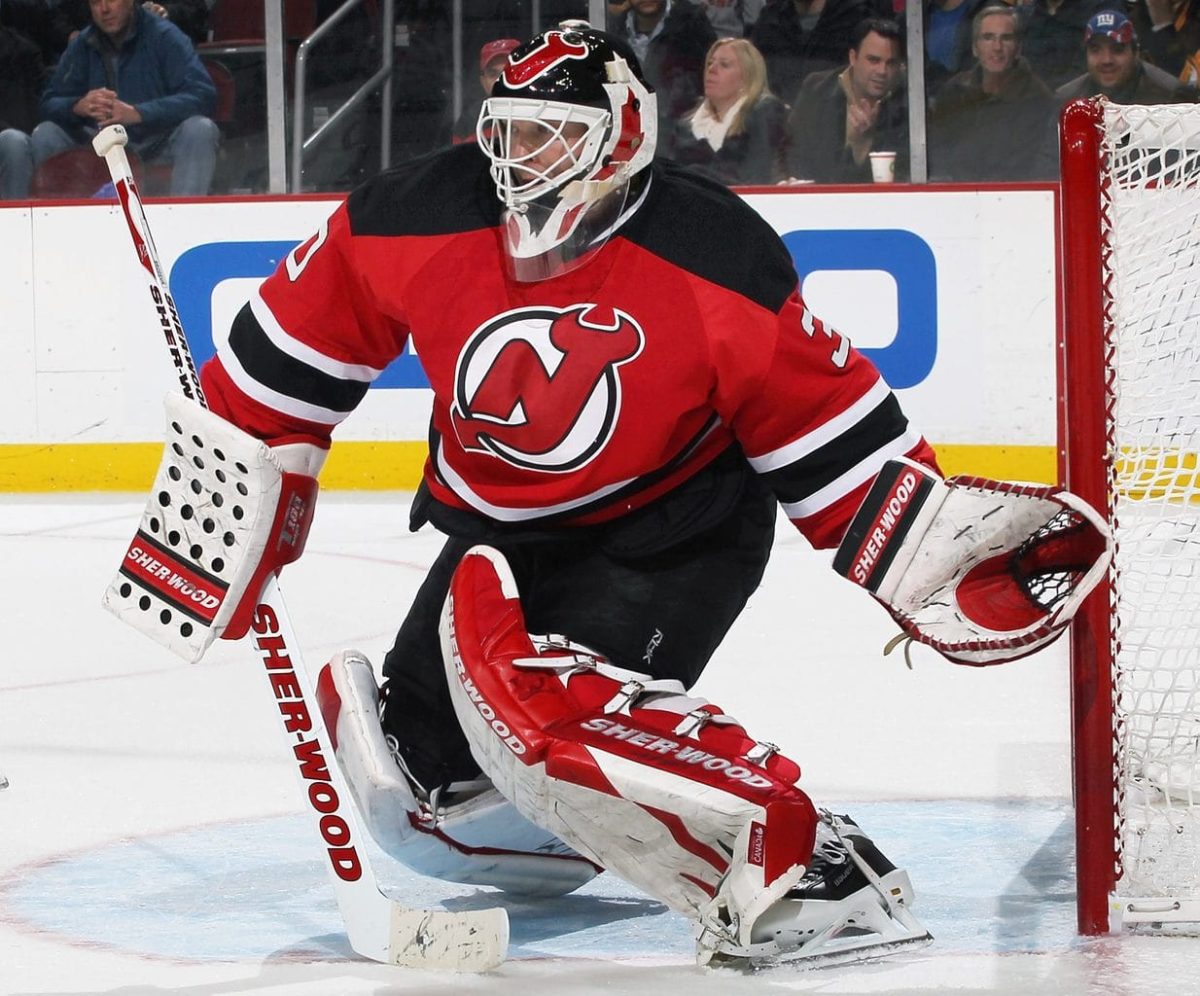The Philadelphia Flyers will most commonly appear in the NHL spotlight on national tv broadcasts against the Pittsburgh Penguins, their arch-rival during the career of Sidney Crosby beginning after 2004-05 lockout. The New York Rangers battled the Flyers most bitterly during the 1970s and 1980s. However, arguably the most contentious rivalry in franchise history ignited during the 1990s with the New Jersey Devils.
The two franchises owned the old Atlantic Division before the realignment of 2013. After the Rangers won the first-ever Atlantic Division crown in 1993-94 and the ensuing Stanley Cup, the Flyers and Devils accounted for 15 of the next 16 regular-season division titles through 2010-11. They finished in the top two spots in nine of 11 seasons from 1994-95 through 2005-06.
The battles always featured the type of players fans hate in an opponent’s uniform but love to see in the sweater of their favorite team. Philadelphia forwards like Eric Lindros, John LeClair, and Rod Brind’Amour constantly battled with defensive-minded cornerstones like Scott Stevens and Scott Niedermayer and legendary goaltender Martin Brodeur.
Contrast in Perceptions of Flyers and Devils
The two franchises in focus represented a contrast in fan perception. Geographic proximity was about the only thing they had in common. Ed Snider had built the Flyers into an organization constantly in the NHL spotlight. Even when their period of six Stanley Cup appearances in 14 years took a downfall in the early 1990s, the Flyers made headlines with one of the most high-profile acquisitions in NHL history by landing the rights to Lindros in 1992.

The Devils had won just two playoff series between the time of their relocation from Colorado in 1982 and the formation of the Atlantic Division. They never featured a superstar scorer who would rival Lindros in offensive spectacles. They occupied an awkward middle ground playing at the Meadowlands just a short distance away from the larger-than-life Rangers at Madison Square Garden and the New York Islanders. The Blue Shirts controlled most of the fan base in North Jersey while Flyers fans occupied most of South Jersey.
The lucrative budget Snider dumped into the Flyers year after year looked like a complete luxury compared to a franchise with seemingly constant instability in its ownership. After rumors of a move to Nashville finally faded in the late 1990s, a move to Newark became inevitable. Former owner John McMullen had already completed a deal to relinquish ownership of the team while the Devils made their Stanley Cup run in the spring of 2000.
The Devils hoisted the Stanley Cup in 1995, 2000, and 2003. Without an obvious location to hold their victory parades, they chose the parking lot of Brendan Byrne Arena (later called Continental Airlines Arena and the Izod Center) instead of making a short trip to Newark. The attendance was a far cry from the local legends of two million people in Philadelphia for Stanley Cup parades during the 1970s.
1995 Eastern Conference Final
The unlikely rivalry truly ignited in 1995 after a lockout shortened the season to 48 games. The Flyers dragged their feet out of the gates with a 3-7-1 start before making one of the most influential trades in franchise history. They acquired John LeClair, Eric Desjardins, and Gilbert Dionne for star winger Mark Recchi.
The new-look Flyers took the ice for the first time on Feb. 11, 1995 against the Devils. LeClair found the back of the net in the first period with assists from Lindros and Desjardins. Philadelphia suddenly took the league by storm with the “Legion of Doom” line in control. Lindros, LeClair, and Mikael Renberg kickstarted a new era of success in Flyers history. Lindros won the Hart Trophy with 70 points in 46 games during the shortened season. Philadelphia cruised to an Atlantic Division title with an eight-point cushion over the Devils and the Washington Capitals.

The two division rivals advanced through the first two rounds with relative ease on a collision course to the Eastern Conference Final. The road team won each of the first five games of the series. The underdog Devils took Game 5 at the Spectrum in Philadelphia behind a deciding goal in the final minute of regulation by Claude Lemieux, the subject of heated venom from Philadelphia fans after a battle with the Montreal Canadiens in 1987.
Lemieux added another third-period goal in Game 6 that helped send the top seed home empty-handed. Lindros led the Flyers with five points in the series, including an overtime winner in Game 3. 15 points in 12 playoff games solidified his breakout season at age 22 and provided the promise of a dynamic future in Philadelphia.
New Jersey general manager (GM) Lou Lamoriello then captured his first of three Stanley Cups. Gord Stellick would later credit “an aura that he (Lamoriello) knew what he wanted, knew what he was doing, and believed he would get there.” The wily GM concentrated objectively on how he could utilize the available resources to build a winner with little concern for outside judgment.
The Devils under Lamoriello became (in)famous for the “neutral zone trap,” a defensive system that stifled opposing attacks without as much concentration on offense. The suffocating style eventually became a major factor in the rule changes made by the NHL at the Shanahan Summit during the 2004-05 lockout. The choice to crack down on clutching and grabbing by defensive players contributed to the transition of the NHL into more of a finesse game ruled by highlight-reel stars instead of bruising defensemen and big wingers along the boards at center ice.
An obscure market team like the Devils winning with a style that pushed the game away from offensive skill didn’t benefit the NHL product overall. Lamoriello instead focused on winning, and he succeeded in a big way that followed nobody’s script except his own.
2000 Eastern Conference Final
The story of the Flyers during this era can’t be told without Lindros at its center. The 6-foot-4, 240-pound power forward dominated the NHL when he was healthy as much as any player in an era of excellent talent. As he suffered a disturbing amount of head injuries, his incredible talent became a secondary issue. His third concussion of the 1999-00 season came against the Boston Bruins in early March 2000. He played four games after the injury before taking a seat and engaging in an ugly battle with management off the ice about the severity of his concussion history.

Former Flyers captain Bobby Clarke, the organization’s GM at the time, stripped the captaincy from Lindros because of disagreements about how he handled the situation. While their star sat out, the Flyers caught fire. They finished first in the Eastern Conference and whipped through the Buffalo Sabres in five games in the opening round of the 2000 Stanley Cup Playoffs. They survived a five-overtime marathon in Pittsburgh on their way to a six-game series victory over Jaromir Jagr and the Penguins to advance to the Eastern Conference Final.
The Devils, meanwhile, took a bizarre path to meet their nemesis, even for Lamoirello. The unpredictable GM pulled the unlikeliest move of his career and fired head coach Robbie Ftorek with eight games remaining in the regular season while his team still occupied the top seed in the East. Hall of Famer Larry Robinson took the bench and led the Devils past the Florida Panthers and the Toronto Maple Leafs in the first two rounds.
Related: History of Stanley Cup Winners That Changed Coaches Midseason
Keith Jones spoke 20 years later about “something special that was really bonding that (1999-00 Philadelphia) team together” in the absence of Lindros. The Flyers recovered from a 4-1 loss in Game 1 of the Eastern Conference Final to win three straight and take a commanding 3-1 series lead over their hated division rivals. LeClair also spoke about past discussions between some of the veteran players and the coaching staff about how a possible Lindros return could hurt the chemistry of a team one win away from the Stanley Cup Final.
When the Flyers did pull the trigger to get big number 88 back in the lineup, their risk looked like it would pay immediate rewards. Lindros jumped directly back into a rhythm of domination. He was the best player on the ice in a 2-1 loss in Game 6. He scored Philadelphia’s only goal. Despite the well-documented tension between Clarke and Lindros, former Flyers beat reporter Chuck Gormley recalled, “I sat there in the press box for Game 6 right next to Clarke. … I never saw Clarke root harder for somebody than for Lindros that night.”
The loss pushed all the pressure onto Philadelphia’s shoulders leading up to Game 7 at home on May 26, 2000. The decibel level inside the arena could’ve blown the roof off the building after Lauren Hart covered Kate Smith’s rendition of “God Bless America” as an homage to the Broad Street Bullies era. Nobody was prepared for what was about to come.
Just under eight minutes into the opening period, Eric Lindros picked up a loose puck at center ice and gained the New Jersey zone. As he crossed the blue line, his long-time adversary Scott Stevens put a shoulder to his jaw with one of the most stunning hits in NHL history. Lindros fell flat on the ice concussed to what had become Stevens’ signature style.
“I was right behind him. I remember yelling to look out and to get your head up. It was early in that game, and then it was just complete silence in the building. It was not a pretty sight. At that moment, I thought his career would be over. I guess it was as a Flyer, but there was a real ominous feeling that came with what happened out there,” said Jones.
The Devils already held a 1-0 lead after an early goal by Patrik Elias. Rick Tocchet scored in the second period to tie the game, but Elias found the net for his second of the night with just 2:32 remaining in regulation. The Devils went on to beat the Dallas Stars for their second Cup in six years. They went back to the Stanley Cup Final the following season and later won their third in nine seasons in 2003. Lindros sat out the 2000-01 season, and the Flyers dealt him to the Rangers in August 2001.
Flyers Get Revenge
Brodeur holds the NHL record for most career shutouts with 125. He was the backbone of the three Stanley Cup teams. He had Philadelphia’s number in particular with 12 career shutouts during the regular season, his most against any opponent. As Ron Hextall faded into the sunset during the peak years of the rivalry, the Flyers resorted to a revolving door in the crease.
Related: 5 Forgotten Flyers Goalies
They followed up Brian Boucher’s miracle rookie run during the 2000 Stanley Cup Playoffs with unsuccessful stints by Roman Čechmánek, Jeff Hackett, and Sean Burke. They won just one playoff series in three seasons after the fateful injury to Lindros in 2000. The 2003-04 season looked like it was following the same path as the Flyers entered the postseason without an established goaltender.
They turned to the unproven Robert Esche for an opening round series against the Devils, who finished just one point behind them in a loaded Eastern Conference playoff picture. The little-known netminder flipped the script on Philadelphia’s kryptonite, allowing just seven goals in a painless five-game series victory. The Flyers caught fire with a reinvigorated core including LeClair, Keith Primeau, Jeremy Roenick, and newcomer Alexei Zhamnov.

The Flyers defeated Toronto to advance back to the Eastern Conference Final, but a new rival took them down this time. A young John Tortorella and the upstart Tampa Bay Lightning edged the Flyers in a tight seven-game series on the way to their first Stanley Cup in franchise history.
The 2010 Stanley Cup Playoffs followed a similar script. The Flyers snuck into the playoffs on the last day of the regular season with a shootout win over the Rangers to earn a first-round matchup against the Atlantic Division champion Devils. Boucher, during his second stint in orange and black, outdueled an aging Brodeur. The Philadelphia netminder’s .940 save percentage (SV%) propelled them to the second round while Brodeur posted just an .881 SV%.
The Flyers met their Waterloo on a magical ride when Patrick Kane scored an overtime winner to stun the home Philadelphia crowd once again. Despite earning revenge on the rival that ended two of the best seasons in franchise history in 1995 and 2000, the Flyers couldn’t close the deal and achieve the same glory of the Devils during the reign of their hated captain Stevens. The Devils also won the most recent playoff series between the two teams in 2012 on their way to another Stanley Cup Final appearance.
Past Flyers-Devils Rivalry
Erik Johnsen of our Devils’ staff at The Hockey Writers recalled the height of the rivalry from a New Jersey perspective.
“As a kid, I always remember that the games between the two teams were always physical. Both the Devils and Flyers had great players that fed into the rivalry, and each team was pretty even on paper. The Devils’ strength was the Flyers’ weakness, and vice versa. It started becoming competitive in the mid-1990s once New Jersey became a powerhouse in the Eastern Conference, and to this day, it seems like the hatred for the other side still persists. It is only two hours or so from Philadelphia to East Rutherford, so it was not uncommon to see the opposing fans in each other’s arena. The playoff matchups between the two sides are some of the most iconic in NHL history, and the rivalry between the Devils and Flyers is one of the Eastern Conference’s most passionate feuds.”
-Erik Johnsen
Love them if they’re on your side. Hate them if they’re on the other. Flyers fans say it about Stevens, Lemieux, and others. Devils fans say it about Lindros, Tocchet, and any/all of the enforcers that Philadelphia employed at the rivalry’s height.
The rivalry between the Flyers and the Devils has slipped in the modern era of the NHL. Harris Blitzer Sports and Entertainment, the ownership group of the Philadelphia 76ers, bought the Devils in 2013. No relevant overlap has risen since, however. The Devils picked Nico Hischier first in the 2017 NHL Entry Draft while the Flyers selected Nolan Patrick second. The potential narrative ended before it ever truly started as Philadelphia dealt Patrick away in 2021.
Since both teams switched to the Metropolitan Division in the realignment in 2013, the Devils have made the postseason just once. The Flyers have three playoff appearances and just one series victory, and they now face the lowest point in their franchise history. As the Devils look like they’ve turned a corner with an excellent start to the 2022-23 season, the Flyers will look to play catch-up.